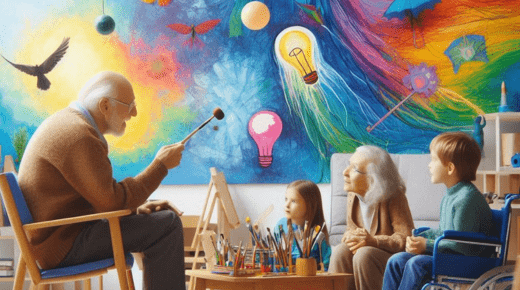Exploring Expressive Arts in ABA Therapy – Creative Pathways to Communication

Introduction
Applied Behavior Analysis (ABA) therapy is widely recognized for its effectiveness in supporting individuals with autism and other developmental disorders. While traditional ABA methods often focus on structured and systematic approaches to behavior modification, incorporating expressive arts into therapy introduces an innovative and holistic dimension. This article delves into how expressive arts serve as creative pathways to communication, offering unique tools for emotional expression, social interaction, and personal growth in ABA therapy.
Understanding Expressive Arts
Expressive arts encompass a broad range of creative practices, including visual arts (painting, drawing), performing arts (music, dance, drama), and even tactile and multi-sensory activities (sculpting, collage). These forms of expression allow individuals to communicate feelings, thoughts, and experiences beyond verbal language. For many, particularly those who struggle with traditional forms of communication, the arts offer an alternative language—a means to express what they might not be able to articulate through speech.
The Intersection of Expressive Arts and ABA Therapy
Incorporating expressive arts into ABA therapy aligns with the primary goals of enhancing communication and social skills. By utilizing creative modalities, therapists can engage clients in less intimidating and enjoyable ways. Here’s how expressive arts can be integrated into various aspects of ABA therapy:
Enhancing Non-Verbal Communication
Non-verbal communication is crucial in interactions, especially for individuals with limited verbal skills. Through activities such as drawing or painting, clients can convey emotions and narratives visually. This practice helps them communicate feelings and serves as a conversation starter, fostering connections with peers and therapists.
Facilitating Emotional Regulation
Expressive arts offer a safe space for individuals to explore and express their emotions. Activities like music therapy or creative movement can help clients process feelings that might be overwhelming or difficult to articulate verbally. Music and movement rhythmic and sensory aspects can efficiently promote relaxation and emotional regulation, enabling clients to navigate challenging situations more effectively.
Encouraging Social Interaction
Group art activities can be a delightful way to cultivate social skills. Collaborative projects encourage teamwork and cooperation, vital for developing social interactions. Engaging in shared creative processes, such as group painting sessions or theatrical performances, can foster a sense of belonging and community among individuals in therapy.
Building Confidence and Self-Esteem
Creativity nourishes self-expression, and when individuals create something unique, it can enhance their confidence. Celebrating their artistic accomplishments, whether a drawing or a performance, instills a sense of pride. This boost in self-esteem can be significant for individuals struggling with self-identity or social acceptance.
Practical Applications of Expressive Arts in ABA Therapy
Art Therapy Techniques
Art therapy can be seamlessly integrated into ABA practices. Here are a few strategies therapists can utilize:
- Emotion Wheel: Create an emotion wheel with various feelings illustrated. Clients can select colors or images representing their emotions and discuss their selections with the therapist, promoting emotional awareness and vocabulary development.
- Story Illustration: Encourage clients to write and illustrate a story. This activity nurtures creativity and comprehension while allowing the therapist to assess the client’s understanding of narrative structure and emotional context.
Music and Movement Activities
Incorporating music and movement can also enrich the therapeutic experience:
- Musical Chairs with Emotions: During a musical chairs game, replace chairs with cards displaying different emotions. When the music stops, clients must express their feelings with a chosen emotion, fostering emotional language and social interaction.
- Dance Therapy: Guided dance sessions can be used as self-expression. Clients can be encouraged to dance freely to various musical styles to emphasize how rhythm and movement can communicate emotions without words.
Drama Therapy
Drama therapy provides an avenue for role-play and social skills development. Here’s how it can be applied:
- Role Reversal: Clients can participate in role-reversal exercises, act out scenarios they find challenging, practice appropriate responses, and enhance their empathy and understanding of social dynamics.
- Storytelling Performance: Engage clients in creating and performing short skits. This collaborative effort encourages communication, teamwork, and the expression of individual ideas and feelings.
The Role of the Therapist
The therapist plays a pivotal role in navigating the integration of expressive arts within ABA therapy. Here are some key responsibilities:
Creating a Safe Space: Therapists must establish an environment where clients feel safe to express themselves without judgment. A nurturing atmosphere encourages exploration and creativity—allowing clients to engage freely in artistic activities.
Individualizing Approaches: Every client is unique, with individual preferences and needs. Therapists should tailor expressive arts activities to align with each client’s interests and strengths, ensuring the creative process is enjoyable and meaningful.
Assessing Progress: In addition to traditional ABA metrics, therapists should incorporate qualitative assessments of clients’ emotional expression and communication skills through their artistic outputs. Regular reflection on progress can help refine the therapeutic approach.
Success Stories
Numerous anecdotes and case studies highlight the transformative power of integrating expressive arts into ABA therapy. For instance, one therapist noted significant improvements in a non-verbal child’s ability to express emotions and interact socially through regular painting sessions. Another case involved a group of teens who bonded over a drama project, fostering friendships and enhancing their social skills through shared creativity.
Conclusion
Exploring expressive arts within Move Up ABA enhances communication pathways and enriches the therapeutic experience as a whole. By nurturing emotional expression and fostering social connections through creative modalities, therapists can empower individuals to communicate meaningfully and authentically. As we advance our understanding of effective therapeutic practices, expressive arts are a vibrant and essential component in the journey toward more excellent communication and connection.






